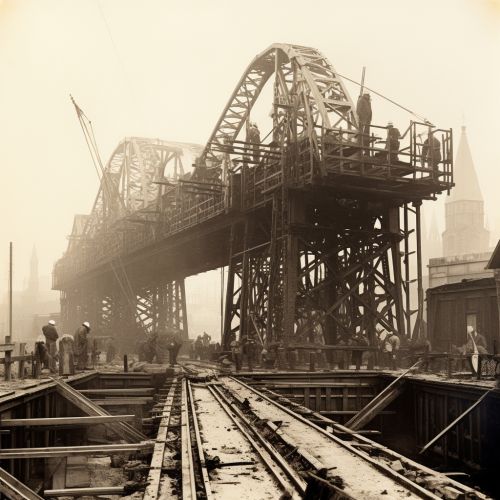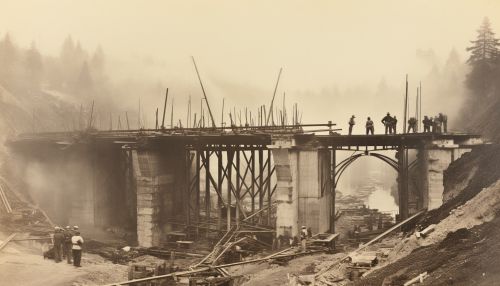Construction of Bridges
Overview
Bridges are critical components of our infrastructure, facilitating transportation and connectivity across various geographical barriers such as rivers, valleys, and roads. The construction of bridges involves a complex process that requires careful planning, design, and execution, employing principles from several fields including civil engineering, materials science, and environmental science. This article delves into the intricate process of bridge construction, providing a comprehensive understanding of the various stages, techniques, and considerations involved.
History of Bridge Construction
The history of bridge construction dates back to the ancient times, with the earliest bridges being simple structures made from natural materials such as wooden logs or stones. The Romans were among the first to use arches in their bridge designs, a technique that significantly improved the strength and stability of the structures. Over the centuries, advancements in technology and materials have led to the development of more complex and efficient bridge designs, such as suspension bridges, cantilever bridges, and cable-stayed bridges.
Types of Bridges
There are several types of bridges, each with their own unique design and construction methods. These include:
- Beam bridges: These are the simplest type of bridges, consisting of a horizontal beam supported at each end by piers. The weight of the bridge and its load is transferred to the piers, which bear the entire load.
- Arch bridges: These bridges utilize the principle of the arch to distribute the weight of the bridge and its load evenly across the entire structure. The arch shape provides inherent strength and stability, allowing these bridges to span large distances.
- Suspension bridges: These bridges are characterized by their main span being hung from cables suspended from towers. The cables transfer the weight of the bridge and its load to the towers, which then transfer the load to the ground.
- Cantilever bridges: These bridges are constructed using cantilevers, structures that are anchored at only one end. The weight of the bridge is balanced by the counterweight of the cantilever.
- Cable-stayed bridges: These bridges are similar to suspension bridges, but the cables are attached directly to the bridge deck, rather than being hung from a main cable.


Bridge Construction Process
The construction of a bridge involves several stages, each requiring careful planning and execution.
Site Selection and Design
The first step in bridge construction is site selection and design. This involves conducting a thorough survey of the proposed site to determine its suitability for bridge construction. The design of the bridge is then created, taking into consideration factors such as the type of bridge, the materials to be used, the load it will carry, and environmental considerations.
Foundation Construction
The foundation is a critical component of a bridge, as it bears the entire load of the structure. The type of foundation used depends on the nature of the soil and the load the bridge will carry. Common types of foundations used in bridge construction include pile foundations, caisson foundations, and spread footings.
Superstructure Construction
The superstructure of a bridge includes the components that will carry the load of the bridge, such as the deck, beams, and trusses. The construction of the superstructure involves assembling these components, either on-site or off-site, and then installing them on the foundation.
Finishing
Once the superstructure is completed, the finishing works are carried out. This includes the installation of railings, lighting, and pavement, as well as the painting and waterproofing of the bridge.
Materials Used in Bridge Construction
Various materials are used in bridge construction, each with their own properties and applications. These include:
- Concrete: This is a common material used in bridge construction due to its strength and durability. It is often used in the construction of the bridge deck and piers.
- Steel: This is used for its high tensile strength and flexibility. It is often used in the construction of the bridge superstructure, particularly in suspension and cable-stayed bridges.
- Wood: This is used for its light weight and ease of use. It is often used in the construction of small pedestrian bridges.
- Composite materials: These are used for their high strength-to-weight ratio and corrosion resistance. They are often used in the construction of bridge decks and railings.
Safety Considerations in Bridge Construction
Safety is a paramount concern in bridge construction. This involves ensuring the safety of the construction workers during the construction process, as well as the safety of the users of the bridge once it is completed. Safety considerations in bridge construction include the use of proper safety equipment, adherence to safety protocols, and regular inspection and maintenance of the bridge.
Environmental Impact of Bridge Construction
Bridge construction can have significant environmental impacts, including habitat destruction, water pollution, and noise pollution. It is therefore important to conduct an environmental impact assessment prior to the construction of a bridge, and to implement measures to mitigate these impacts.
Future Trends in Bridge Construction
Advancements in technology and materials science are driving the development of new techniques and materials in bridge construction. These include the use of advanced composite materials, the application of 3D printing technology, and the integration of smart technology into bridge design.
